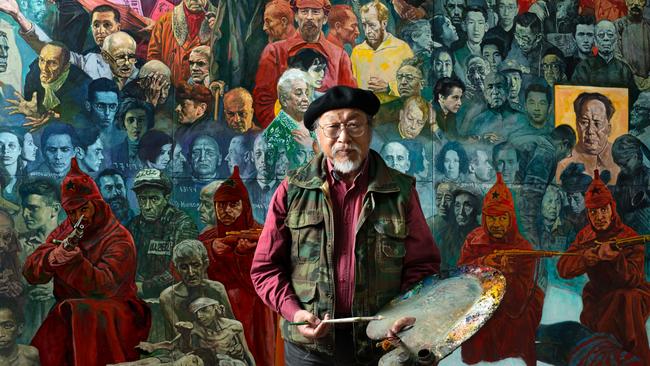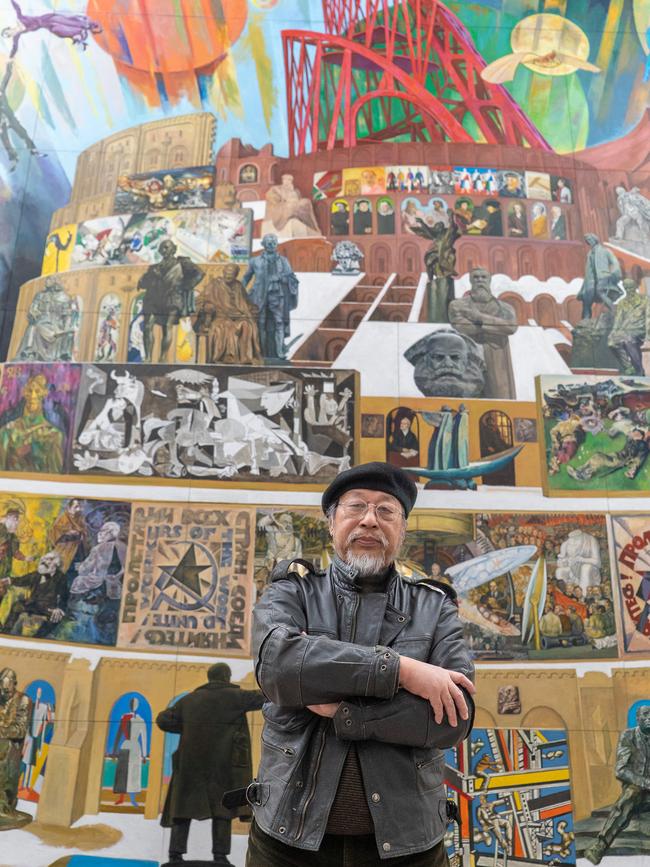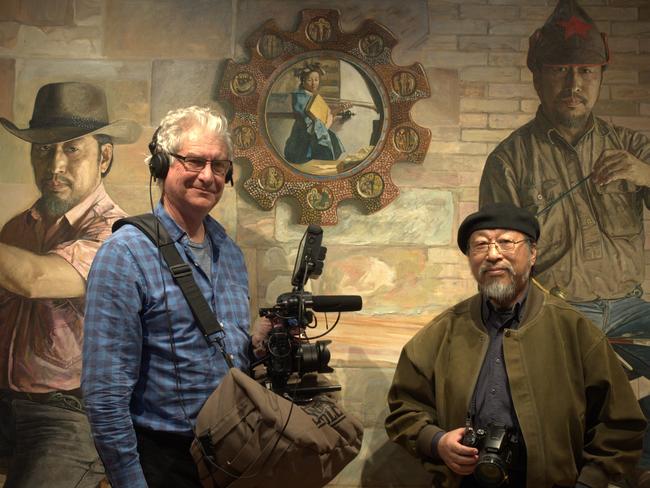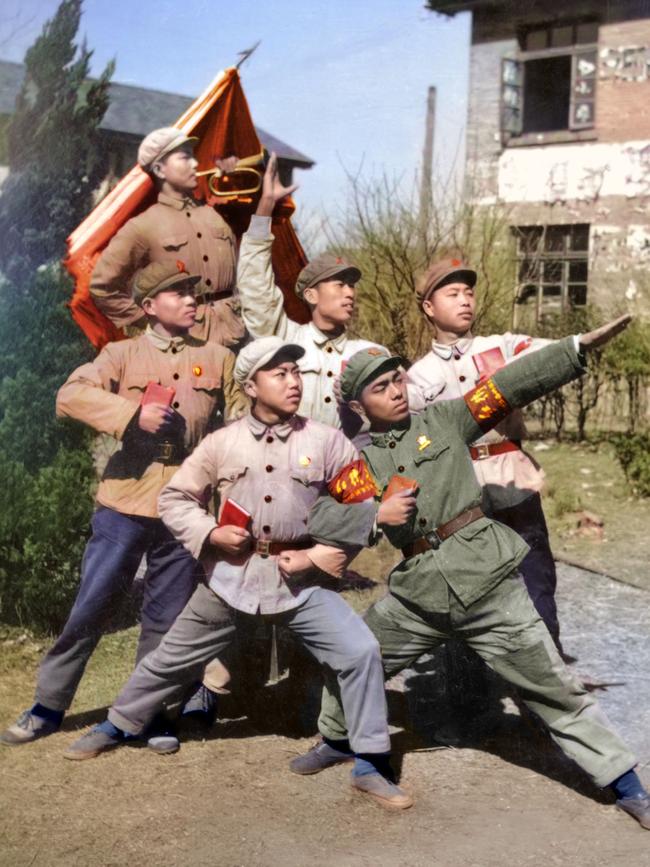Director James Bradley records artist JiaWei Shen creating Tower of Babel in a new documentary
An enthralling documentary about the creation of a unique work of art charts the history of communism and its impact on one long-suffering family.

Chinese artist JiaWei Shen first met film director James Bradley 12 years ago in Sydney at the screening of Bradley’s documentary about a Chinese artist working with Indigenous groups. Shen, who first came to Australia in the late 1980s and was allowed to stay when then prime minister Bob Hawke promised residence for people from mainland China in Australia after the Tiananmen Square massacre on June 4, 1989, had gone on to become famous as a portrait painter in Australia.
His work has included portraits of Denmark’s Queen Mary, former prime minister John Howard, former governor-general Sir Peter Cosgrove, and Pope Francis.
Shen was planning a master work in his studio in the southern Sydney beachside suburb of Bundeena, about the history of communism, called the Tower of Babel, and wanted Bradley to record the process.
It was the start of a journey of more than a decade as Bradley paid regular visits to Shen’s studio to film the creation of his complex historical masterpiece, while also learning of the personal stories of Shen and his wife, Lan Wang, who grew up in China during the Cultural Revolution.

It was a journey that took much longer than Bradley expected including a visit to China in 2015 with Shen and Wang, Bradley and his Hong Kong born wife Cathy Li who was helping with the film, Cathy’s death from cancer in 2019 and then several years of Covid.
The result is a labour of love which is about both Shen’s painting of the Tower of Babel – works of the artist featuring hundreds of individual figures, over four walls of a house especially built for the painting – and the life story of Shen and Wang, who’s also an artist.
Welcome to Babel, Tower of Dreams & Nightmares, was first screened at the Sydney Film Festival earlier this year where it won the Documentary Australia Award for the best documentary, and more recently at the Art Gallery of NSW.
It will be released in selected theatres in November.
Bradley describes the documentary as having “a lot of depth and a lot of heart” – a combination of the intensity of Shen’s passion about the lessons from the history of communism around the world and his life growing up in communist China and then coming to Australia.

Shen says he wanted the documentary to be made to get the word out about the messages in his Tower of Babel work which is confined to the walls of his Sydney home.
As he explains, it was an epic project which only he could do, given his unique career as a historical artist, and his life in both communist China and Australia.
“I had 40 years’ life experience in China under the communist system and 35 years living in Australia in the Western world,” he tells Review.
“It means I can look back at this history from the point of view of both sides. It is much better than people who have only had one experience.”
Shen became famous in China for painting Standing Guard for Our Great Motherland, a propaganda work he made in 1974 featuring heroic Chinese soldiers in a guard house looking out across a river at the Russian border in the winter snow.
The painting was seen by Madam Mao who loved it and put it in the National Art Museum in China, making Shen famous.
It was a journey which saw him invited to come to Australia in the late 1980s.
Once a Communist Party member, including signing up as a Little Red Guard in the Cultural Revolution, Shen tells the story of the idealism of those around the world who have supported communism as a way to counter injustices and create a better world, and the resultant authoritarian regimes that kill those who are against them.

“The Tower of Babel is a metaphor I use,” Shen explains.
“When I was a child, we were always talking about the fact that we were building the great communist building,” he said.
“It was the same thing as the Tower of Babel.”
His work, which was painted over seven years, he sees as the crowning achievement of his career, which depicts the rise of the communist movement in the 20th century.
It is an enormous work of 90 separate panels over four walls, totalling 130sq m and is 7.5m high.
The panels depict more than 400 famous and infamous characters including politicians, soldiers, scientists, artists, writers and filmmakers who were won over by the utopian vision of the communist movement – and many whose lives were lost to communist revolutions, including during China’s Great Famine and its Cultural Revolution.
It also includes Shen’s own remix of more than 100 left-wing artists including Picasso, Matisse, Leger, Goya, Diego Rivera and Frida Kahlo.
Shen says his work provides the history lesson of those idealistically supporting communism, including great writers and artists, and the reality of Communist regimes.
“Many people who supported communism did it because they wanted a better world,” he explains.
“But it turned into a horrible disaster. Instead of providing Utopia it saw regimes killing their own people.”
Tower of Babel includes a reference to a work by Spanish painter Francisco Goya who did a painting called Saturn Devouring His Son.
The film intertwines Shen’s work over the years on his masterpiece with the story of him growing up in China and his move to a farm in northeastern China where he did the Motherland painting and met Wang, who had been sent to the area for re-education from Beijing because her parents were seen as Rightists.
While the documentary was originally focused on Shen, Bradley also became interested in his wife Wang, who has her own very distinctive artistic style, and whose family suffered during the Cultural Revolution.
It is clear Wang would prefer her husband take a much lower key and enjoy their life in Australia, not reviving the horrors of the past, including those experienced by them and their families, through a constant reflection about the history of communism.
“She did two main interviews for the film,” Bradley recalls.
“The final one came during the editing process when we felt we needed more detail about her story.
“We had to persuade her to do it, but we got some emotional stuff.
“She was reluctant to tell some things because she didn’t think people would believe her or take her seriously.
“But when I convinced her that people would believe her she began to talk, saying ‘I’ve got to tell the truth’.
“It was symptomatic of a lot of Chinese people who went through the Cultural Revolution and suffered but they don’t talk about it.” It was also an exercise that resulted in their daughter, Xini (pronounced Sidney), learning much more about her parents’ life in China than she ever knew.

Viewers of the documentary inevitably ask Shen whether it will see him banned from going back to China, where his wife still has close family.
While he is cautious he still has an open mind about whether his work will prevent him returning to China, arguing that he is just a student of history and not part of any political movement.
Tower of Babel is the story of an extraordinary person; a driven, talented artist with a passion for the sweep of history and the follies of communist “idealism” and its real life experience.
But it is also a story of one migrant family from China who made their way in Australia living off their unique mixture of skill and hard work.
Documentary Australia chair Andrew Myer, a member of the Myer family, is executive producer of the film, which comes at a critical time in Australia-China relations.
Welcome to Babel is in Cinemas from November 14. The film screens this weekend at the Capital Film Festival, Canberra.

